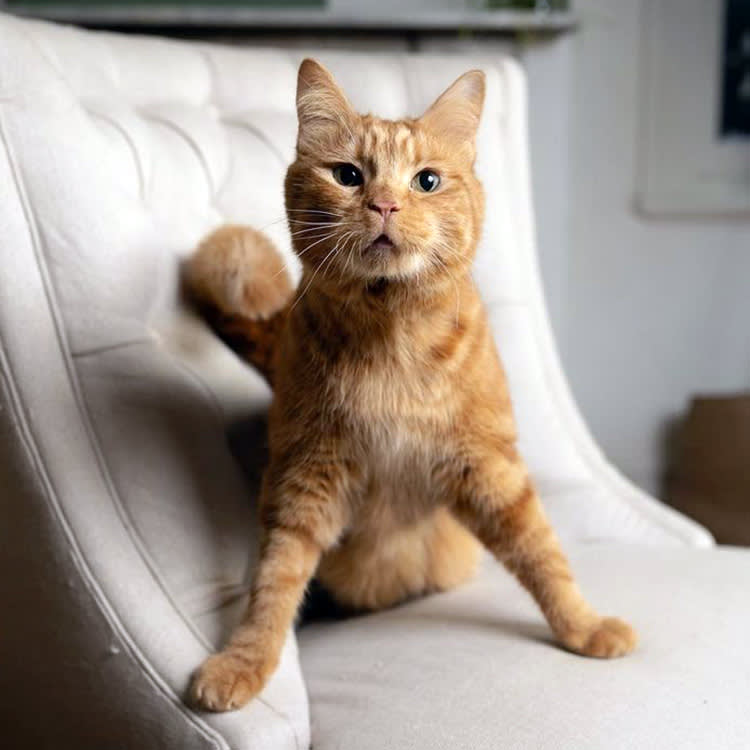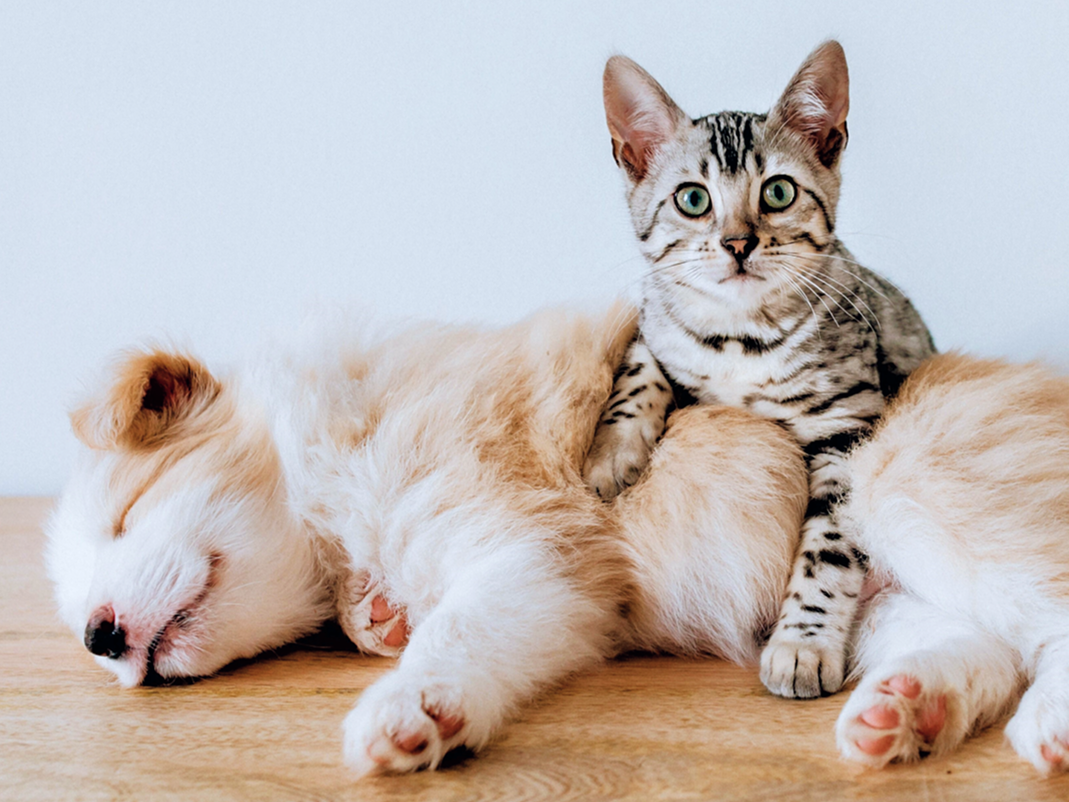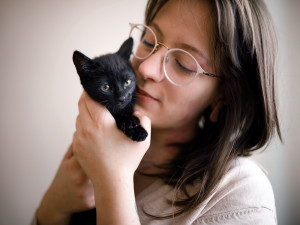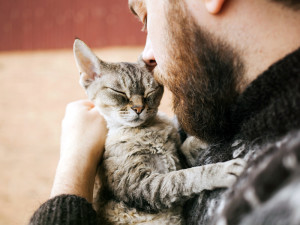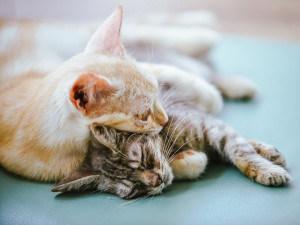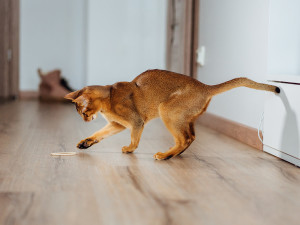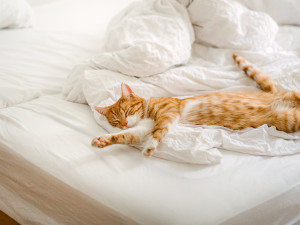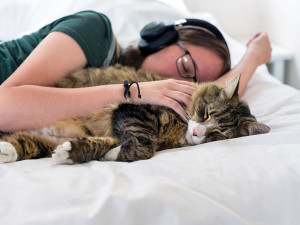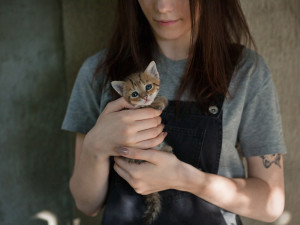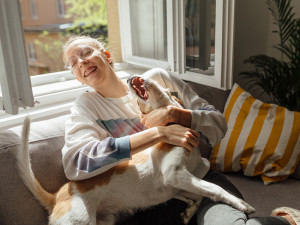“Wobbly Cat Syndrome” Is All Over the Internet—But What Are These Cats Really Like?
The pet parents of Phineas, a beloved social media star, tell us all about living with a cat with cerebellar hypoplasia.
Daria and Collin Anderson knew exactly what they were getting into when they adopted their cat Phineasopens in new tab, a charismatic and spunky social media star. The ginger kitty has cerebellar hypoplasia (CH), a rare neurological condition commonly known as “wobbly cat syndrome” (explained in his very own TikTok video hereopens in new tab), which causes him to shake when he attempts any sort of movement — from walking and jumping to eating and using his litter box — and which they both have studied.
The condition occurs when the feline parvovirus is passed from infected female cats to their offspring, either in utero or during the first two weeks of nursing. “The virus affects the growth of the cerebellum, which controls balance, coordination, and fine-motor movements,” veterinarian Dr. Preston Turanoopens in new tab says.
Check out customizable policies from our friends at Lemonade Pet Insurance—so you only pay for what you need.
Don’t be too concerned, though. Dr. Turano adds that “the disease does not continue to progress after the initial damage, and most cats will live a normal life, other than experiencing some issues with balance.”
The internet loves a wobbly cat
It‘s the balance issues that have caught the eye of online cat admirers. Wobbly cats have become the subject of much social media fascination — if you search “wobbly cat,” along with articles about CH, you’ll find TikTok and Instagram accounts of other popular kitties who walk with an adorably shaky gate.
How much do you spend on your pet per year?
On TikTok alone, you'll find Phineas, of course, as well as other other sought-after personalities, like Macaroniopens in new tab, a tabby who boasts an impressive 80K followers. Or there‘s Flounder,opens in new tab whose TikTok accountopens in new tab (which features other entertaining rescue as well) has 380K followers.
But as much as they might like to marvel at wobbly cats, for people unfamiliar with CH, the prospect of caring for a cat with the condition, or any sort of special needs, can be overwhelming. Luckily for Phineas, the Andersons knew better. They both earned their PhDs studying movement disorders, like CH, and the year before they adopted Phineas, Collin began postdoctoral work on the cerebellum.
So, when the couple saw Phineas on @cats_of_instagramopens in new tab, they knew he was theirs. They were confident that, physical issues aside, a cat with CH could live as happy, normal, and long a life as any other cat.
“We felt that we could provide him with an understanding home,” Collin says. “And when there weren’t good local adopters for him, I flew out from Utah to Washington, D.C. to adopt him and bring him home!”
How Phineas became a social media sensation
And Phineas certainly has a full life. With 1.4 million TikTok followers and one million Instagram acolytes, this little orange wobbly guy has the kind of social media engagement today’s reality TV stars could only dream of.
Because the Andersons found Phineas on Instagram, they decided to make him his own account so his foster mom and her own followers could see how he was doing. Over the next coupe years, his online popularity took off.
And for good reason — Phineas is a charmer. Click on any of his videos, and you’ll find comments from devoted TikTok fans like, “LIL WOBBLY CAT HE’S SO CUTE!” But mostly, they just comment on his delectably adorable personality and — another TikTok fascination — his “orange cat energy,” just as they would any other cat.
“I think people love Phin because he combines that obvious wobbly gait with a massive, oversized personality, Collin says. “You wouldn't expect a cat like him to be so confident and sure of himself, but he certainly is!”
Collin says the online wobbly cat community is strong and that he and Daria often chat with other CH parents. “There are quite a few cats that we’ve helped find homes for, so it’s particularly fun to stay in touch with their families,” he says. “There are also a few CH groups on social media.”
How to spot a cat with wobbly cat syndrome
Cats with CH will often walk or stand with their legs far apart, sway when they move, lift their legs high when walking, and nod or experience head tremors, especially when eating or focusing. Even though their balance is compromised and they are prone to falling, they are not weak; when they are still or sleeping they look just like any other cats.
“Vets can typically diagnose CH based on history and exam findings,” Dr. Turano says. “However, if a clear diagnosis cannot be made that way, a CT or MRI will show a smaller cerebellum, indicative of the disease. Beyond that, signs and symptoms really depend on how much damage occurs to the cerebellum and how much it affects their balance.”
Caring for a cat with wobbly cat syndrome
Although the virus that causes CH is highly contagious, it is effectively prevented with a vaccine. CH also cannot be passed to other cats, so the Andersons were able to introduce Phineas to their other cat, Tyrion, and the two of them soon became good friends. The Andersons are also currently fostering two 12-week-old kittens with very Disney names, Sebastian and Maurice, who also have CH. (This videoopens in new tab of Phineas, Sebastian, and Maurice trying to have dinner will add some serotonin to your day.)
“They get along great,” Collin says. “They play together a lot, actually. And although they can each be a bit protective of their meals, they respect each other and don’t try to take each other’s food.”
Cats with CH do require some special care, but not nearly as much as you might expect. “Cats with CH should be kept indoors or under supervision when in a fenced backyard,” says Dr. Turano. “Falling is the biggest concern, and injuries related to falls may need to be addressed. But other than the wobbles, these cats can live very normal, healthy lives.”
“To be honest, I don’t think that caring for a cat with CH is nearly as difficult as most people would think,” Collin adds. “There are a lot of minor adaptations around the home that help, but beyond that, it’s really not that tough.” He suggests getting some soft rugs, having sturdy throws and bed sheets so they can climb up and down furniture, getting a litter box setup that enables them to lean up against a wall while using it, and having soft food bowls.
The biggest adjustment the Andersons made to accommodate Phineas occurred only recently, when they bought a new house. “We bought a 100-plus-year-old fixer-upper, and the stairs were so steep that they wouldn’t have been safe even for us to go up and down, let alone Phineas,” Collin says.
So, they ripped out the stairs and installed new ones that would be more manageable for Phineas to walk up. They opted for a mostly carpet-less house but chose to put carpet on the stairs just to give him some traction. They realize redoing the stairs might be thought of as “a pretty extreme case of adapting the home” for a cat, but he’s mastered the new staircase, and everyone is happy.
“Phin is an all-around great cat,” Collin says. “He has a massively oversized personality and a ton of love to give. He loves to cuddle and spend time with us, and the small amount of additional work that he requires means that he pays us back with extra love tenfold. He’s incredibly sweet, and I can’t imagine a better cat.”
